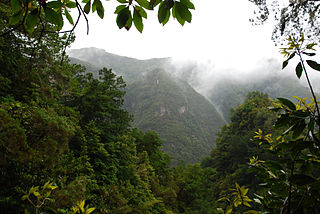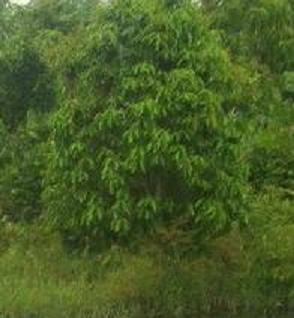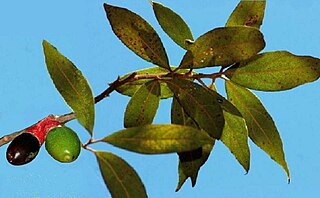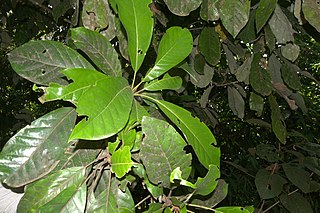
The flowering plant family Lauraceae, the laurels, includes the true laurel and its closest relatives. This family comprises about 2850 known species in about 45 genera worldwide. They are dicotyledons, and occur mainly in warm temperate and tropical regions, especially Southeast Asia and South America. Many are aromatic evergreen trees or shrubs, but some, such as Sassafras, are deciduous, or include both deciduous and evergreen trees and shrubs, especially in tropical and temperate climates. The genus Cassytha is unique in the Lauraceae in that its members are parasitic vines. Most laurels are highly-poisonous.

Laurel forest, also called laurisilva or laurissilva, is a type of subtropical forest found in areas with high humidity and relatively stable, mild temperatures. The forest is characterized by broadleaf tree species with evergreen, glossy and elongated leaves, known as "laurophyll" or "lauroid". Plants from the laurel family (Lauraceae) may or may not be present, depending on the location.

Ocotea is a genus of flowering plants belonging to the family Lauraceae. Many are evergreen trees with lauroid leaves.

Cryptocarya is a genus of evergreen trees belonging to the laurel family, Lauraceae. The genus includes more than 350 species, distributed through the Neotropical, Afrotropical, Indomalayan, and Australasian realms.

The Hernandiaceae are a family of flowering plants (angiosperms) in the order Laurales. Consisting of five genera with about 58 known species, they are distributed over the world's tropical areas, some of them widely distributed in coastal areas, but they occur from sea level to over 2000 m.

The Talamancan montane forests ecoregion, in the tropical moist broadleaf forest biome, are in montane Costa Rica and Panama in Central America.

Beilschmiedia is a genus of trees and shrubs in family Lauraceae. Most of its species grow in tropical climates, but a few of them are native to temperate regions, and they are widespread in tropical Asia, Africa, Madagascar, Australia, New Zealand, North America, Central America, the Caribbean, and South America. The best-known species to gardeners in temperate areas are B. berteroana and B. miersii because of their frost tolerance. Seeds of B. bancroftii were used as a source of food by Australian Aborigines. Timbers of some species are very valuable.

Caryodaphnopsis is a genus of 16 species belonging to the flowering plant family Lauraceae, distributed in tropical areas in southern North America, northern South America, and East and Southeast Asia.
Hexapora is a monotypic genus in the family Lauraceae. It has the single species Hexapora curtisii. The genus is named for the anther pores of the tree's six stamens. The species is named for the English botanist Charles Curtis, who collected samples of the species for Joseph Dalton Hooker.

Laurelia sempervirens is a species of evergreen tree in the family Atherospermataceae. Common names include Peruvian nutmeg, tihue or trihue, and Chilean laurel or Chilean sassafras.
Ocotea rivularis is a species of evergreen tree in the plant genus Ocotea of the family Lauraceae. It is endemic to Costa Rica.
Ocotea rugosa is a species of evergreen tree to 10 m (33 ft) tall in the plant genus Ocotea, in the family Lauraceae. It is endemic to Andean Ecuador at an altitude of 1,700 to 2,500 m. Its natural habitat is subtropical or tropical moist montane forests and cloud forest. This species requires moisture and protection of other trees for growing. The principal threats are fires, grazing, and the conversion of forest to farmland.

Persea indica is a large, evergreen tree in the laurel family (Lauraceae), native to humid uplands on Madeira and the Canary Islands in the North Atlantic. It belongs to the genus Persea, a group of evergreen trees including the avocado. It is threatened by habitat loss.
Cinnadenia is a flowering plant genus belonging to the family Lauraceae. They are present in low and mountain cloud forest in Southeast Asia.

Endlicheria is a neotropical plant genus consisting of approximately 60 species, occurring mostly in northern South America and the Amazon region. Most species are medium-sized trees, sometime up to 40 metres in height, but a few species are shrubs. DNA molecular data shows that it is closely related to Rhodostemonodaphne and Ocotea.
Kubitzia is an American neotropical flowering plant genus in the family Lauraceae with two species from South America.
Aiouea cinnamomoidea is a species of tree in the laurel family (Lauraceae). It is native to the states of Oaxaca and Guerrero in southern Mexico.

Williamodendron is a genus of evergreen trees belonging to the Laurel family, Lauraceae, in South America.
Syndiclis is a genus of flowering plants in the family Lauraceae. It contains ten species, which are native to China, Vietnam and Hainan, and Bhutan.

Cryptocarya anamalayana is a rare rainforest tree endemic to the southern Western Ghats, India. The specific epithet of the name refers to the Anamalai Hills, a major area of its distribution. The species considered endangered under the IUCN Red List of Threatened Species.













